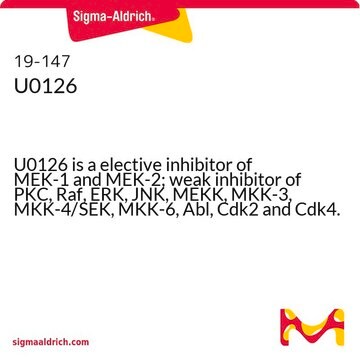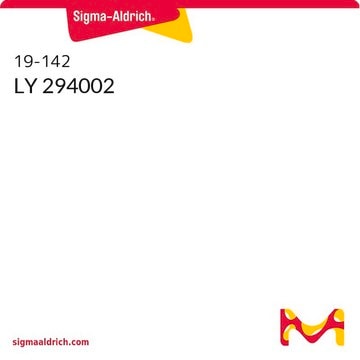662009
U0126
InSolution, ≥98%, A potent and specific inhibitor of MEK1 and MEK2
Sinónimos:
InSolution U0126
About This Item
Productos recomendados
Nivel de calidad
Ensayo
≥98% (HPLC)
Formulario
liquid
fabricante / nombre comercial
Calbiochem®
condiciones de almacenamiento
OK to freeze
avoid repeated freeze/thaw cycles
desiccated (hygroscopic)
protect from light
Condiciones de envío
ambient
temp. de almacenamiento
−70°C
cadena SMILES
S(c2c(cccc2)N)\C(=C(\C(=C(\Sc1c(cccc1)N)/N)\C#N)/C#N)\N
InChI
1S/C18H16N6S2/c19-9-11(17(23)25-15-7-3-1-5-13(15)21)12(10-20)18(24)26-16-8-4-2-6-14(16)22/h1-8H,21-24H2/b17-11+,18-12+
Clave InChI
DVEXZJFMOKTQEZ-JYFOCSDGSA-N
Descripción general
Envase
Advertencia
Forma física
Reconstitución
Otras notas
Información legal
Código de clase de almacenamiento
10 - Combustible liquids
Clase de riesgo para el agua (WGK)
WGK 1
Punto de inflamabilidad (°F)
188.6 °F - closed cup - (Dimethylsulfoxide)
Punto de inflamabilidad (°C)
87 °C - closed cup - (Dimethylsulfoxide)
Certificados de análisis (COA)
Busque Certificados de análisis (COA) introduciendo el número de lote del producto. Los números de lote se encuentran en la etiqueta del producto después de las palabras «Lot» o «Batch»
¿Ya tiene este producto?
Encuentre la documentación para los productos que ha comprado recientemente en la Biblioteca de documentos.
Los clientes también vieron
Nuestro equipo de científicos tiene experiencia en todas las áreas de investigación: Ciencias de la vida, Ciencia de los materiales, Síntesis química, Cromatografía, Analítica y muchas otras.
Póngase en contacto con el Servicio técnico











